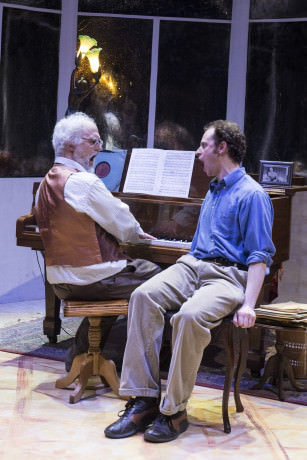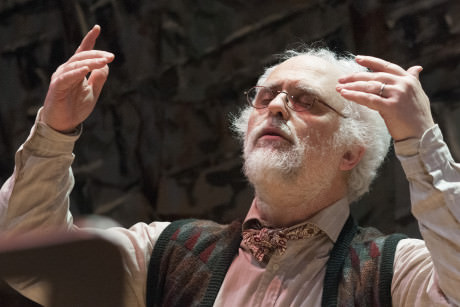Occasionally, a show blows me away and I want to grab the arm of people walking by on the street and steer them to the production. “Come. Join in experiencing this beautiful piece of art.” This is the reason why I write reviews of plays. I get to witness many performances and then share what moved me, hopefully enticing others to see fantastic shows. So, if you are reading this and feel something tugging your sleeve, that’s me. Because this is one of those superb productions.

Old Wicked Songs at 1st Stage is astounding and among the best plays I have seen this year. This production is well worthy of a play that was a Pulitzer Prize finalist in 1996, and you should make plans to see it. The intimacy of the space transports you into the world of the show and the two actors are mesmerizing.
Among the many strengths of this production, the most visible is the acting talent. Philip Hosford plays Professor Josef Mashkan, an aging, but passionate teacher who is meeting in his Viennese music studio with a difficult student. The arrogant piano prodigy from America, Stephen Hoffman (played by Aaron Bliden) is trying to get past the mental block which has halted his career. From the opening when light reveals Mashkan at the piano, Hosford reveals depth of his character. An errant note immediately stops his playing and he looks at, then massages, his arthritic hands, appealing to them, “Nein.” Bliden plays young Stephen as a smug, typically impatient American who wants answers and results. His transformation in the play is beautifully portrayed, and I was struck by his ability to embed such depth of emotion into his singing.
Sparks fly between the two, but it quickly becomes clear that each needs the other. The play is centered around the music that brings the two together, and requires that both actors play the piano, as well as sing. While the show is more frequently billed as a drama, the musical talent is exemplary and the music director Bobby McCoy and singing consultant Jane Margulies Kalbfeld deserve kudos. And as long as we are crossing borders of genres, you will be glad to know the play also is wonderfully funny.

The story touches on multiple issues that resonate; the power of music, of masterful mentors, and of compassion. One of the recurrent themes was the requirement for sadness to beget great happiness, as well as great art. Mashkan suggests to Stephen that the greatest musicians tend to come from countries that have much misery. As interesting as these insights were, I found myself led down another path.
Every day someone tells me that our society is losing the ability to communicate. While the internet and other technology allows us to communicate faster with more people, the messages are often superficial. Are we connecting and communicating at a deep level? Old Wicked Songs is rampant with wisdom and we are given a lovely example of how art fosters meaningful connection and understanding. The insights gained by looking at something deeply, with curiosity and perseverance certainly speaks to the teacher in me, but more personally, to the human searching to understand myself and humanity.
Old Wicked Songs is beautifully supported by the production team. Direction by Michael Chamberlin is self-assured, thoughtful, and crisp. The pace of the play is masterful, shifting tempos like the best music to tell the story dramatically and to enthrall. Referring to music, advice is suggested in the play; that one must give space for silence to allow the richness of the art to be received. Don’t mistake me, the play never dragged and each moment of quiet was calculated and powerfully revealing about the characters. The audience gains insights and enjoys a more clear understanding of music, poetry, and intimate communication. We are all enriched by such mentors as Mashkan, as the playwright Marans, and director Chamberlin.
From the moment I entered the performance space, I was struck by the intimate atmosphere created by Set Designer Kathryn Kawecki. The space has been transformed from a proscenium style theatre (in which the audience all faces the same direction towards the stage) to an acting space that mixes aspects of a runway and a thrust stage. The space does not hold a large number of seats, but every seat is excellent and none farther than 20 feet from stage. Tiers for seating have been blocked off with a temporary wall, leaving some of the potential audience space unused. This bold design choice has huge impact on many levels, first and foremost is the creation of the intimacy. The audience feels as though it is inside Mashkan’s atelier, nearly surrounding the music teacher at his lessons. As close as the audience is, I would have appreciated smelling real coffee from the pot that frequently refilled one of the many cups strewn about the studio. The walls surrounding the audience provide an arresting backdrop. Torn pieces of cardboard are haphazardly shingled from floor to ceiling, and then the walls are painted with a suggestion of elegant old buildings, perhaps a European city’s skyline. My audience companion correctly guessed Vienna.
Despite other audience members visible on the other side of the theater beyond the acting space, my attention was gripped by the two actors onstage. This is quite a tribute to Lighting Designer Brian S. Allard, whose powerful choices shifted the moods as well as the scenes, brought us into a character’s isolation, and reminded us with lightning that the world produces power we humans cannot control.
Sound design by Kenny Neal provided brilliant moments, such as scene change music shifting from the house speakers to the record player on the stage, moving from the perfection a musician imagines to the scratchy reproduction of a well-loved and oft-played record. Rain and thunder worked with the lighting to provide dramatic mood shifts. Perhaps it was a glitch or maybe I misheard, but prior to the show, I was confused when I heard what I think was pre-show sound effects which seemed to cut in and out over the house sound system.

The staging is a risky choice, though there is no doubt of the artistic power of bringing the audience so close to the performers. The downside is the potential loss of revenue for the theater company. Loss of the seats that could have been fit into the space means that potential audience members cannot purchase tickets for those seats and the theater may be reducing income. I don’t know if 1st Stage generally sells out, so can’t calculate the cost of the choice. I do know that the artistic excellence shown at all levels deserves full houses, and I fear with fewer seats available, they may have to turn people away. I know that I will be coming back for future shows with great anticipation.
Running Time: Two hours and 15 minutes, with one intermission.
Old Wicked Songs plays through May 3, 2015 at 1st Stage – 1524 Spring Hill Road, in McLean, VA. For tickets, call the box office at (703) 854-1856, or purchase them online.
RATING:






Thank you for your wonderful review. We appreciated it and so will our son We have seen the play many times and have always enjoyed it.